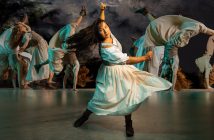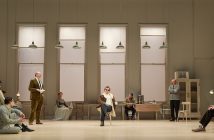When you read the premise of Yasmina Reza’s play Art, it feels as though this 90-minute three hander could be rather hard work to watch – a bit of a chore, a means of justifying a nice large glass of something once the curtain has fallen.
Not so. Though the dialogue is dense, nay relentless, in this extended philosophical ponderance on fine art and friendship, Reza retains a lightness of touch, often through her bone dry wit; the work is peppered with humour (sometimes banal, sometimes sour) that keeps the mood lifted and never allows the big topics in hand to bog everything down. And for a female writer, Reza has uncannily observed the nature of male friendship, and the conversations that go on within it.
First shown 20 years ago, Art is the tale of three friends whose relationship is pulled this way and that by a disagreement over a painting. Throughout, Reza questions whether there can be objectivity in art, whether opinions matter, whether we should withhold hurtful opinions from friends, and just what friendships are based on in the first place through various meetings of different combinations of this group. The original run starred Albert Finney, Tom Courtenay and Ken Stott, ran for eight years and won Reza an Olivier Award. So Rufus Sewell, Paul Ritter and Tim Key have a marked weight of expectation on their shoulders for this anniversary stint at The Old Vic, under which they seem to thrive.

Photography (c) Manuel Harlan
Sewell plays Serge, a wilful divorcee whose latest infatuation happens to be with a fiendishly expensive, not to mention divisive painting, despite its capacity to take him to financial ruin. Dashing and debonair as ever, Sewell could believably lust over anything – even a big white square, as he does here.
Sitting on the other side of the aesthete’s fence is old bore and old friend Marc, an engineer whose artistic imagination does not stretch to these contemporary extremes. He can’t for the life of him conceive how this canvas could constitute art, let alone be something worth bankrupting oneself over, and his no-frills manner of expressing this opinion pushes his friendship with Serge to the brink. Ritter meanders between stubborn pomposity and friendly concern, flitting between the role of a stick in the mud to irritate us and an anchor to keep us engaged when the conversation threatens to get too abstract. Marc is the realist to Serge’s romantic, the chalk to his headily pungent cheese.
Plonked right in the middle – literally, according to most of the stage direction – is Yvan, who can see both sides and is susceptible to vast manipulation by his so-called chums. Whilst he bends over backwards to keep the peace, the other two do not turn out to be quite so willing to help him through his own personal crisis, when family tensions threaten to implode in the run-up to his impending marriage, about which he isn’t exactly excited any how. Key’s tirade when his friends’ continued uselessness proves too much is a moment of theatre magic: hyperventilating, despairing, frantic, maddened and exhausted, one watches agog as the words tumble ceaselessly from Key’s lips, his face reddening with each one, until you wonder how much longer he can survive without breath, and just how many more words an actor can remember in such rapid succession.

Photography (c) Manuel Harlan
It is little outbursts like this that spike the show with vivacity in what is otherwise a very sleek, very understated production. Reza famously said that she was surprised at the reception to Art – “I thought I had written a tragedy,” she said – and there is a decidedly Pinter-esque vibe to the piercingly clear characters obstinately heading for destruction here.
The original creative team has been drawn back together by Matthew Warchus, and we are once again privy to the men’s goings on in their chic Parisian apartments, which are depicted by white paneling and differentiated only by the changing of a picture on the wall. The set otherwise comprises a coffee table and three chairs, one for each character: the austere old-world scrooge, the inoffensive crowd-pleaser and the ultra-nouveau visionary. In terms of the giant white painting, that translates as atheist, agnostic and theist.
Go and see it for yourself to decide which one you are.
At the Old Vic until 18th February 2017. For more info, visit the website.




